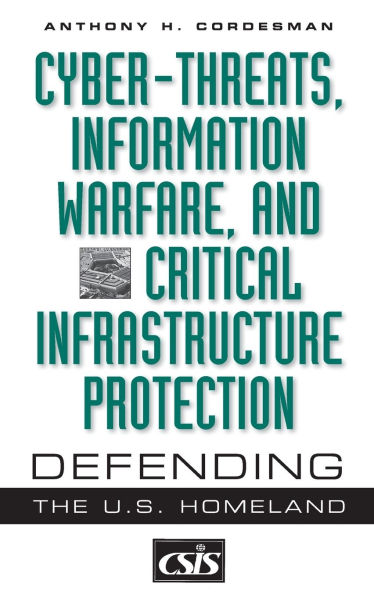Cyber-threats, Information Warfare, and Critical Infrastructure Protection: Defending the U.S. Homeland
During the last two decades, the infrastructure of the U.S. economy has undergone a fundamental set of changes. It has steadily increased its reliance on its service sector and high-technology economy. The U.S. has come to depend on computers, electronic data storage and transfers, and highly integrated communications networks. The result is the rapid development of a new form of critical infrastructure—and one that is exceedingly vulnerable to a new family of threats, loosely grouped together as information warfare. This detailed volume examines these threats and the evolving U.S. policy response.
After examining the dangers posed by information warfare and efforts at threat assessment, Cordesman considers the growing policy response on the part of various federal agencies, state and local governments, and the private sector. The changing nature of the threats is leading these actors to reassess the role they must play in critical infrastructure protection. Government at all levels, industry, and even friendly and neutral foreign governments are learning that an effective response requires coordination in deterrence, defense, and counterattack.
1111303002
After examining the dangers posed by information warfare and efforts at threat assessment, Cordesman considers the growing policy response on the part of various federal agencies, state and local governments, and the private sector. The changing nature of the threats is leading these actors to reassess the role they must play in critical infrastructure protection. Government at all levels, industry, and even friendly and neutral foreign governments are learning that an effective response requires coordination in deterrence, defense, and counterattack.
Cyber-threats, Information Warfare, and Critical Infrastructure Protection: Defending the U.S. Homeland
During the last two decades, the infrastructure of the U.S. economy has undergone a fundamental set of changes. It has steadily increased its reliance on its service sector and high-technology economy. The U.S. has come to depend on computers, electronic data storage and transfers, and highly integrated communications networks. The result is the rapid development of a new form of critical infrastructure—and one that is exceedingly vulnerable to a new family of threats, loosely grouped together as information warfare. This detailed volume examines these threats and the evolving U.S. policy response.
After examining the dangers posed by information warfare and efforts at threat assessment, Cordesman considers the growing policy response on the part of various federal agencies, state and local governments, and the private sector. The changing nature of the threats is leading these actors to reassess the role they must play in critical infrastructure protection. Government at all levels, industry, and even friendly and neutral foreign governments are learning that an effective response requires coordination in deterrence, defense, and counterattack.
After examining the dangers posed by information warfare and efforts at threat assessment, Cordesman considers the growing policy response on the part of various federal agencies, state and local governments, and the private sector. The changing nature of the threats is leading these actors to reassess the role they must play in critical infrastructure protection. Government at all levels, industry, and even friendly and neutral foreign governments are learning that an effective response requires coordination in deterrence, defense, and counterattack.
74.0
Out Of Stock
5
1

Cyber-threats, Information Warfare, and Critical Infrastructure Protection: Defending the U.S. Homeland
200
Cyber-threats, Information Warfare, and Critical Infrastructure Protection: Defending the U.S. Homeland
200Related collections and offers
74.0
Out Of Stock

Product Details
| ISBN-13: | 9780275974237 |
|---|---|
| Publisher: | Bloomsbury Academic |
| Publication date: | 11/30/2001 |
| Series: | Praeger Security International |
| Pages: | 200 |
| Product dimensions: | 6.14(w) x 9.21(h) x 0.50(d) |
| Lexile: | 1560L (what's this?) |
About the Author
From the B&N Reads Blog
